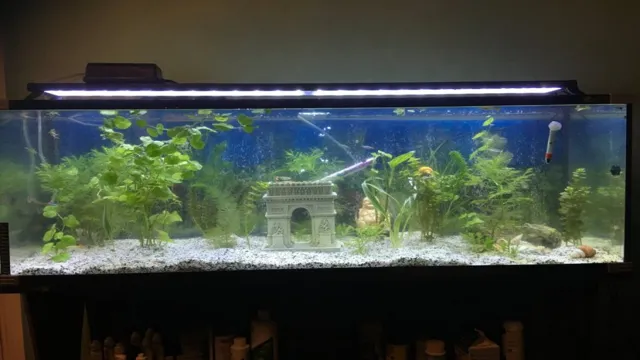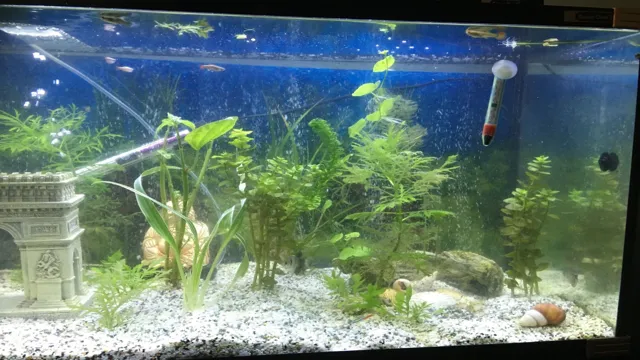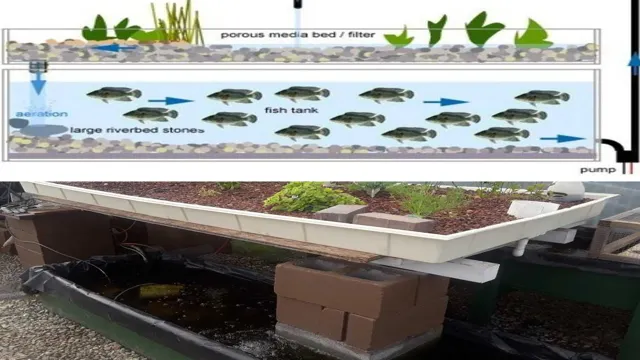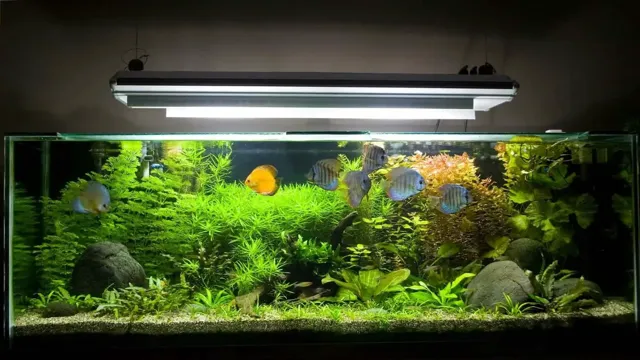Do you want a healthy and thriving aquarium, but are struggling with high levels of carbonate hardness? High carbonate hardness can cause your tank’s pH to fluctuate, making it difficult for fish and plants to thrive. But don’t worry, there are steps you can take to lower carbonate hardness and create a stable environment for your aquatic pets. First, it’s important to understand what carbonate hardness is and how it affects your aquarium.
Carbonate hardness is the measure of dissolved carbonate and bicarbonate ions in your tank’s water. These ions help regulate pH levels, but too much can cause pH swings and even harm your fish. Luckily, there are several ways to lower carbonate hardness.
One option is to perform regular water changes and replace some of the old water with water that has lower carbonate hardness levels. Another option is to add natural substances such as driftwood or peat moss to your tank, which can help lower carbonate hardness over time. It’s also important to test your water regularly and make adjustments as needed.
You can use pH test kits to monitor the pH levels in your tank and adjust as necessary. Additionally, adding a buffer to your aquarium can help stabilize pH levels and prevent sudden drops or spikes. In conclusion, lowering carbonate hardness in your aquarium is crucial for creating a stable and healthy environment for your fish and plants.
By understanding the causes and taking steps to lower it, you can ensure a beautiful and thriving aquatic ecosystem in your home.
What is Carbonate Hardness?
Carbonate hardness (KH) is a measure of the amount of dissolved carbonate and bicarbonate ions in your aquarium water. It is an important parameter to monitor as it affects the pH stability of your tank. A high KH level can lead to excessive buffering, making it challenging to decrease pH levels when necessary.
If you want to lower the KH level in your aquarium, there are several methods you can try. One option is to use peat moss or almond leaves which contain tannins that will gradually lower the KH levels over time. Another approach is to perform partial water changes with water that has a lower KH level.
Using reverse osmosis (RO) or distilled water can help reduce KH levels too. However, it’s important to monitor and adjust the KH slowly and gradually to prevent any sudden drops in pH, which can be detrimental to your aquatic inhabitants. By maintaining the carbonate hardness at the optimal level, you can ensure a healthy and stable environment for your aquatic pets.
Explanation of Carbonate Hardness
Carbonate hardness, also known as KH or alkalinity, is a measure of the bicarbonate and carbonate ions present in your aquarium water. These ions help to stabilize pH levels and prevent harmful fluctuations that can stress out your fish and other aquatic life. Carbonate hardness is important to monitor because it affects the overall health and well-being of your aquarium inhabitants.
If the KH level is too low, pH levels can become unstable and lead to stress, illness, and even death. On the other hand, if the KH is too high, it can cause pH levels to remain too high, making it difficult for aquarium plants to thrive. Therefore, it’s important to test and maintain a balanced KH level in your aquarium.
Regular monitoring and adjustments can help ensure a healthy environment for your aquatic friends.

Why is it Important to Lower Carbonate Hardness?
Carbonate hardness, also known as KH or alkalinity, is the measure of the concentration of carbonate and bicarbonate ions in water. It can have a significant impact on the health and well-being of aquatic life, making it crucial to maintain appropriate levels. High levels of carbonate hardness can lead to increased algae growth and pH levels, which can be harmful to fish and plants.
By lowering carbonate hardness, you can create a more stable aquarium environment and improve the health of your aquatic pets. It’s important to note that sudden changes in carbonate hardness can also be harmful, so it’s essential to make any adjustments gradually over time. Overall, monitoring and maintaining proper levels of carbonate hardness is an essential aspect of creating a healthy and thriving aquatic ecosystem.
Testing Your Aquarium’s Carbonate Hardness
Carbonate hardness, often referred to as KH, is an essential parameter to measure in an aquarium. It reflects the amount of carbonate and bicarbonate ions present in the water, which are critical for maintaining the pH level and buffering the water against sudden changes. Testing the KH is relatively simple and can be done using a KH test kit. (See Also: How to Clean Plants to Get Rid of Snails: A Complete Guide for Your Aquarium Maintenance)
Once you have measured the KH level, you can determine whether you need to lower it. To decrease KH, you can perform partial water changes with distilled or RO water, add peat moss or driftwood to the tank, or use specialized products that lower carbonate hardness. However, keep in mind that KH is vital for the health of your fish and plants, so be careful not to lower it too much.
Monitoring the KH level regularly is crucial to maintaining a stable and healthy aquatic environment.
How to Test Carbonate Hardness
Testing your aquarium’s carbonate hardness is crucial to maintaining a healthy aquatic environment. Carbonate hardness, also known as KH, refers to the amount of dissolved bicarbonate and carbonate ions in the water. It is important to test KH regularly as it determines the water’s ability to buffer pH changes and prevent sudden drops or spikes that can harm fish and plants.
To test KH, you can use a KH test kit, which typically involves adding drops of a reagent to a water sample until the color changes. The number of drops needed indicates the KH level. Keeping your aquarium’s KH at an appropriate range will aid in the overall stability of your tank.
Understanding Your Test Results
Testing Your Aquarium’s Carbonate Hardness When it comes to maintaining a healthy aquarium, testing your water parameters is crucial, and one of the most important tests to perform is the carbonate hardness test. Carbonate hardness (KH) measures the amount of carbonates and bicarbonates in the water, which affect the pH and buffering capacity in your tank. A low KH can lead to drastic pH swings and can harm your fish, while a high KH can make it difficult to adjust the pH if necessary.
To test your aquarium’s KH, simply fill a test tube with water and add the test reagent drop by drop until the color changes. The number of drops used will correspond with your KH value, which should ideally be between 3-8 dKH. By regularly monitoring your KH levels, you can ensure a stable and healthy environment for your aquatic pets.
Methods for Reducing Carbonate Hardness
If you’re struggling with high carbonate hardness levels in your aquarium, there are a few methods you can try to reduce them. One approach is to use reverse osmosis (RO) water, which filters out dissolved solids and minerals, including carbonates. Another option is to add natural materials like peat moss or driftwood to the tank, which can release organic acids and lower pH levels, subsequently reducing carbonate hardness.
Additionally, performing regular water changes can dilute the carbonate hardness in the tank over time, as long as the new water has lower levels of carbonate hardness. Finally, adjusting the pH levels with a pH-lowering agent can also reduce carbonate hardness. Whatever method you choose, make sure to monitor your water parameters regularly to ensure the changes are having the desired effect and not negatively impacting your aquarium’s inhabitants.
With some patience and persistence, you can successfully lower carbonate hardness levels in your aquarium and create a healthier environment for your aquatic pets.
Water Changes
Water changes are an essential component of aquarium maintenance. To keep fish healthy and happy, it is vital to maintain appropriate levels of water hardness. Excess carbonate hardness can cause pH imbalances and, in turn, harm fish and plants living in the aquarium.
One effective method for reducing carbonate hardness in aquarium water is by doing partial water changes. This approach involves replacing between 10% and 25% of the aquarium water with fresh, dechlorinated water on a weekly or bi-weekly basis. By doing this, the overall hardness of the water can be decreased.
Another method for reducing carbonate hardness is by using an RO water filtration system. This system uses reverse osmosis technology to eliminate excess minerals, including carbonate hardness, from the water. Another option is to use chemical products that contain chelating agents to bind to excess minerals, reducing the overall hardness of the water.
It is important to monitor the water hardness regularly to make sure that it stays in the optimal range for the specific species living in the aquarium. (See Also: How to Dissolve Aquarium Salt: Tips and Tricks for Successful Dissolving)
Using RO/DI Water
If you’re in the aquarium hobby, you know that having the right water parameters is important for the health and well-being of your fish and other aquatic creatures. One aspect of water quality that often gets overlooked is carbonate hardness (KH). KH measures the amount of carbonates and bicarbonates in your water, which can affect pH and overall water chemistry.
Fortunately, there are methods for reducing carbonate hardness, such as using reverse osmosis/deionization (RO/DI) water. RO/DI water is highly purified and lacks minerals like carbonates, which means it has a low KH value. By using RO/DI water for water changes and topping off your aquarium, you can gradually lower the KH level.
Another method is to use pH-lowering products that contain acids like citric acid or acetic acid, which can reduce KH and lower pH. However, it’s important to use these products sparingly and with caution, as too much acid can harm your aquarium inhabitants. Whatever method you choose, monitor your KH levels regularly to ensure a stable and healthy environment for your aquatic pets.
Adding Acidic Substances
Reducing carbonate hardness in aquariums can be achieved by adding acidic substances. One effective method is to use peat moss or sphagnum moss in the filtration system. The tannins in the moss will release organic acids, which will lower carbonate hardness as well as the pH level.
Another option is to add driftwood or oak leaves to the aquarium. As these materials decay, they release tannins and humic acids that will help reduce the carbonate hardness. However, it is important to monitor the pH level as too much acidity can harm aquatic life.
A safe and effective way to lower carbonate hardness is by using commercial products such as pH decreasers or buffer solutions. These products are specifically designed to lower the pH level and carbonate hardness in aquariums without causing harm to the fish and other aquatic species. It is important to follow the instructions carefully and test the water regularly to ensure the desired pH and carbonate hardness levels are maintained.
Maintaining Optimal Carbonate Hardness Levels
One important aspect of maintaining a healthy aquarium is to ensure that the carbonate hardness levels (KH) remain at optimal levels. If you’re wondering how to lower carbonate hardness in your aquarium, there are a few things you can do. First, consider using reverse osmosis (RO) water for your aquarium.
RO water has a low KH and can help to dilute the high KH levels in your tank. It’s also important to monitor your tank’s pH levels, as high KH levels can lead to high pH levels, which can be harmful to your fish. Adding driftwood or almond leaves to your aquarium can help to lower KH levels naturally by releasing tannins into the water.
Finally, consider using a KH-reducing product specifically designed for aquariums. By taking these steps, you can ensure that your aquarium’s KH levels remain optimal and your fish remain healthy.
Recommended Range for Different Types of Fish
Maintaining optimal carbonate hardness levels is crucial when it comes to creating a healthy and flourishing aquatic environment for different types of fish. Different fish species have varying Carbonate Hardness (KH) requirements, which must be met to ensure their overall well-being. For example, herbivorous fish like Tangs generally require a higher KH range of 8 to 12, while more delicate species like shrimp require much lower levels of KH, around 4 to
Maintaining optimal carbonate hardness levels can be a bit tricky, but it can be achieved by balancing pH levels, proper aeration, and alkalinity. Measuring KH periodically is highly recommended to ensure that carbonate hardness levels are always within the recommended range for your specific fish species, contributing to a healthy and happy aquatic environment.
Regular Testing and Monitoring
Maintaining optimal carbonate hardness levels in your aquarium is crucial to fostering a healthy environment for your fish and plants. Regular testing and monitoring are necessary to ensure that the carbonate hardness remains stable and within the appropriate range for your specific aquatic species. Carbonate hardness plays a vital role in buffering fluctuations in pH levels and preventing sudden drops that can be harmful to your aquatic life. (See Also: How to Care for Snails in an Aquarium Cuteness: Tips for a Happy and Healthy Snail Tank)
An adequate carbonate hardness level also promotes the growth of healthy and vibrant plants, which in turn provide oxygen and aid in maintaining a stable ecosystem. Think of it like a balancing act where you need to provide just the right amount of support to keep everything stable and healthy. By staying on top of regular testing and monitoring, you can maintain the optimal carbonate hardness needed for a thriving aquatic environment.
Conclusion
In conclusion, lowering carbonate hardness in your aquarium can feel like a daunting task, but with the right approach, it’s no fish tale. By incorporating a few simple methods such as regular water changes, utilizing RO or distilled water, and implementing a natural pH-lowering substrate, you can ensure a thriving aquatic environment for your beloved underwater pals. Remember, a clean tank is a happy one, and with a lower carbonate hardness, you’ll be swimming in success.
“
FAQs
What causes high carbonate hardness in an aquarium?
High carbonate hardness can be caused by a variety of factors such as overdosing of chemicals, using hard tap water, or not performing regular water changes.
Why is it important to lower carbonate hardness in an aquarium?
High carbonate hardness can lead to pH instability, which can be harmful to fish and plants. Therefore, it is essential to keep the carbonate hardness in check.
What is the ideal range of carbonate hardness for an aquarium?
The ideal range for carbonate hardness in an aquarium is between 3-7 dKH (degrees of carbonate hardness).
How can I test the carbonate hardness in my aquarium?
You can use a test kit specifically designed to measure carbonate hardness. These kits are readily available at most aquarium supply stores.
What are some methods to lower carbonate hardness in an aquarium?
Some effective ways to lower carbonate hardness in an aquarium include using reverse osmosis water, adding peat moss or almond leaves, or performing regular water changes with soft water.
Can adding acid to the aquarium lower carbonate hardness?
Adding acid to the aquarium is not recommended as it can cause pH fluctuations, which can be harmful to fish and plants.
How often should I test the carbonate hardness in my aquarium?
It is recommended to test the carbonate hardness in your aquarium every one to two weeks, especially if you are experiencing pH fluctuations or other water quality issues.







